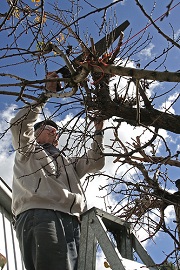If you have a chiminea or other outside heater, you should take a moment to think about the fuel you’re burning.
Your carbon footprint is affected by the fuel you use – and by the carbon emitted during the production, packing, and transportation of that fuel.
Instead of buying timber, why not try burning garden waste?
Every time you’re out working in the garden, consider reusing everything you can. Instead of throwing something away, think about burning it instead. Even a medium-sized garden can generate a surprising amount of green waste, and you can supplement it with junk mail, waste paper, cardboard, and egg cartons. Some garden waste can go into the compost bin, but never compost diseased garden waste or weeds; there is no guarantee the disease will be eradicated and weed seeds may also survive, so it’s best for your garden to burn these items immediately.
Garden waste is effectively carbon-neutral as vegetation absorbs as much carbon dioxide over its life-cycle as it will release when burned.

reuse and recycle some of that waste generated by the autumn pruning and garden clearance as carbon neutral fuel for your garden chiminea
Turning garden waste into fuel
Green garden waste contains a lot of nitrogen and should be dried thoroughly before burning. Drying garden waste transforms a lot of this nitrogen into carbon and results in a more efficient burn and less smoke. Never burn grass clippings or leylandii clippings as they both produce a lot of smoke.
If your garden is overlooked by deciduous trees, you’ll get plenty of free fuel in the autumn. Just allow the leaves to dry thoroughly, then rake them into paper bags. These bags can be thrown on the fire or stored in a cool dry place until they’re needed.
Twigs and branches make good fuel.
Cut them into pieces and allow them to dry out. Smaller twigs can be added to the fire within a day or two, but larger pieces will need more time to dry. A good rule of thumb is if moisture oozes from the cut ends of the wood when it is burned, it needs a little longer to dry.
If you have larger cuts of wood, season them before burning. Cut them into logs and make a wood store. You’ll need a sheltered area, loosely covered with a tarpaulin if possible to allow the air to circulate between the logs. Ensure the area is slightly elevated to stop water pooling underneath, and keep the logs for at least 6-9 months.
Green garden clippings can be spread out in the sun to dry, or hang them in a shed or other dry, protected place for a few days.
There are also a variety of log- and briquette-makers on the market which will take smaller waste items (such as leaves and papers) and compress them into handy logs for the fire.
Hopefully this has given you some ideas for sourcing eco-friendly green fuel from your garden and you’ll be able to reuse and recycle some of that waste generated by the autumn garden clearance.
img http://farm5.static.flickr.com/4081/4738330084_00a0820fac.jpg
